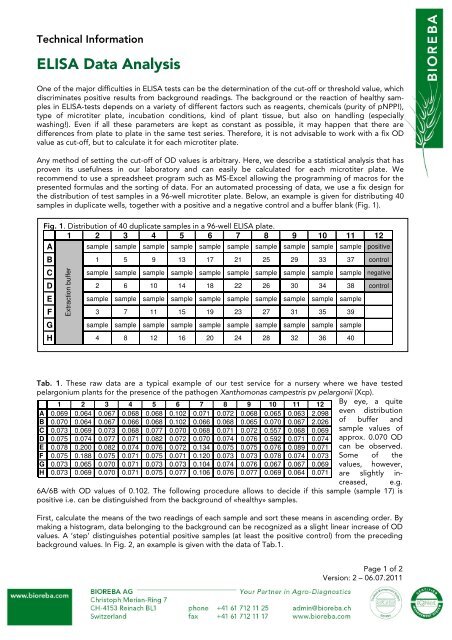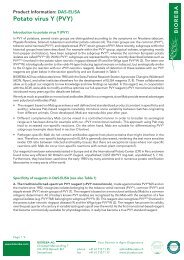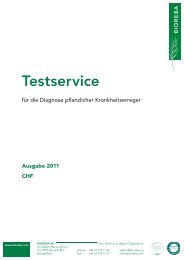ELISA Data Analysis
ELISA Data Analysis
ELISA Data Analysis
Create successful ePaper yourself
Turn your PDF publications into a flip-book with our unique Google optimized e-Paper software.
Technical Information<br />
<strong>ELISA</strong> <strong>Data</strong> <strong>Analysis</strong><br />
One of the major difficulties in <strong>ELISA</strong> tests can be the determination of the cut-off or threshold value, which<br />
discriminates positive results from background readings. The background or the reaction of healthy samples<br />
in <strong>ELISA</strong>-tests depends on a variety of different factors such as reagents, chemicals (purity of pNPP!),<br />
type of microtiter plate, incubation conditions, kind of plant tissue, but also on handling (especially<br />
washing!). Even if all these parameters are kept as constant as possible, it may happen that there are<br />
differences from plate to plate in the same test series. Therefore, it is not advisable to work with a fix OD<br />
value as cut-off, but to calculate it for each microtiter plate.<br />
Any method of setting the cut-off of OD values is arbitrary. Here, we describe a statistical analysis that has<br />
proven its usefulness in our laboratory and can easily be calculated for each microtiter plate. We<br />
recommend to use a spreadsheet program such as MS-Excel allowing the programming of macros for the<br />
presented formulas and the sorting of data. For an automated processing of data, we use a fix design for<br />
the distribution of test samples in a 96-well microtiter plate. Below, an example is given for distributing 40<br />
samples in duplicate wells, together with a positive and a negative control and a buffer blank (Fig. 1).<br />
Fig. 1. Distribution of 40 duplicate samples in a 96-well <strong>ELISA</strong> plate.<br />
1 2 3 4 5 6 7 8 9 10 11 12<br />
A sample sample sample sample sample sample sample sample sample sample positive<br />
B 1 5 9 13 17 21 25 29 33 37 control<br />
C sample sample sample sample sample sample sample sample sample sample negative<br />
Extraction buffer<br />
D 2 6 10 14 18 22 26 30 34 38 control<br />
E sample sample sample sample sample sample sample sample sample sample<br />
F 3 7 11 15 19 23 27 31 35 39<br />
G sample sample sample sample sample sample sample sample sample sample<br />
H 4 8 12 16 20 24 28 32 36 40<br />
Tab. 1. These raw data are a typical example of our test service for a nursery where we have tested<br />
pelargonium plants for the presence of the pathogen Xanthomonas campestris pv pelargonii (Xcp).<br />
1 2 3 4 5 6 7 8 9 10 11 12<br />
A 0.069 0.064 0.067 0.068 0.068 0.102 0.071 0.072 0.068 0.065 0.063 2.098<br />
B 0.070 0.064 0.067 0.066 0.068 0.102 0.066 0.068 0.065 0.070 0.067 2.026<br />
C 0.073 0.069 0.073 0.068 0.077 0.070 0.068 0.071 0.072 0.557 0.068 0.069<br />
D 0.075 0.074 0.077 0.071 0.082 0.072 0.070 0.074 0.076 0.592 0.071 0.074<br />
E 0.078 0.200 0.082 0.074 0.076 0.072 0.134 0.075 0.075 0.076 0.089 0.071<br />
F 0.075 0.188 0.075 0.071 0.075 0.071 0.120 0.073 0.073 0.078 0.074 0.073<br />
G 0.073 0.065 0.070 0.071 0.073 0.073 0.104 0.074 0.076 0.067 0.067 0.069<br />
H 0.073 0.069 0.070 0.071 0.075 0.077 0.106 0.076 0.077 0.069 0.064 0.071<br />
By eye, a quite<br />
even distribution<br />
of buffer and<br />
sample values of<br />
approx. 0.070 OD<br />
can be observed.<br />
Some of the<br />
values, however,<br />
are slightly increased,<br />
e.g.<br />
6A/6B with OD values of 0.102. The following procedure allows to decide if this sample (sample 17) is<br />
positive i.e. can be distinguished from the background of «healthy» samples.<br />
First, calculate the means of the two readings of each sample and sort these means in ascending order. By<br />
making a histogram, data belonging to the background can be recognized as a slight linear increase of OD<br />
values. A ‘step’ distinguishes potential positive samples (at least the positive control) from the preceding<br />
background values. In Fig. 2, an example is given with the data of Tab.1.<br />
Page 1 of 2<br />
Version: 2 – 06.07.2011
Fig. 2. Histogram of sorted mean values.<br />
Tab. 2. Formula for calculation of the cut-off value<br />
cut-off = mean + 3 s + 10 %<br />
In this histogram, means 1 - 35 show a linear<br />
increase of OD values. The 36 th value exhibits a<br />
clear increment compared to the foregoing<br />
values. This «step» has to be determined for<br />
each processed microtiter plate. The calculation<br />
of the cut-off then indicates if the next values<br />
on the right side of the step (indicated with an<br />
arrow) can be considered as positive or not; in<br />
other words, if these values are significantly<br />
different from the preceding «background». In<br />
this example, the calculation of the cut-off has<br />
been done with mean values 1-35 using the<br />
following formula (Tab. 2):<br />
mean: mean of the mean values up to the step (mean values 1-35) = 0.072<br />
s: standard deviation of first 35 mean values = 0.004<br />
cut-off = (0.072 + (3 x 0.004)) x 1.1 = 0.092<br />
Tab. 3. Calculation of means and comparison with cut-off value (values in mOD)<br />
1 2 3 4 5 6 7 8 9 10 11 12<br />
mean 73 64 67 67 68 102 69 70 67 68 65 2062<br />
A 64 67 68 68 102 71 72 68 65 63 2098<br />
B 64 67 66 68 102 66 68 65 70 67 2026<br />
result - - - - positive - - - - - positive<br />
mean 72 75 70 80 71 69 73 74 575 70 72<br />
C 69 73 68 77 70 68 71 72 557 68 69<br />
D 74 77 71 82 72 70 74 76 592 71 74<br />
result - - - - - - - - positive - -<br />
mean 194 79 73 76 72 127 74 74 77 82 72<br />
E 200 82 74 76 72 134 75 75 76 89 71<br />
F 188 75 71 75 71 120 73 73 78 74 73<br />
result positive - - - - positive - - - - -<br />
mean 67 70 71 74 75 105 75 77 68 66 70<br />
G 65 70 71 73 73 104 74 76 67 67 69<br />
H 69 70 71 75 77 106 76 77 69 64 71<br />
result - - - - - positive - - - - -<br />
In Tab. 3, all means<br />
were compared with<br />
the cut-off value of<br />
92 mOD. The means<br />
of the samples<br />
3 (194 mOD),<br />
17 (102 mOD),<br />
23 (127 mOD),<br />
24 (105 mOD), and<br />
34 (575 mOD)<br />
were interpreted as<br />
positive. To avoid<br />
false positives, check<br />
the single values as<br />
well. In some cases,<br />
one value can be<br />
relatively high (e.g.<br />
caused by insufficient washing) and therefore giving a mean that corresponds not to the reality. Therefore,<br />
as a rule, check if both values contributing to the calculation of the mean are above the cut-off.<br />
Recommendation: The level of background can be different for different plant tissues (e.g. leaves, sprouts,<br />
and tubers) or for different species/varieties of plants. In order to obtain an even distribution of the unspecific<br />
reactions contributing to the background, use as homogenous samples as possible in one microtiter<br />
plate.<br />
Conclusion: This data interpretation helps to avoid false negatives in case of weak positive samples with an<br />
antigen concentration near the detection limit. It allows therefore taking full advantage of the sensitivity of<br />
<strong>ELISA</strong> tests.<br />
Page 2 of 2<br />
Version: 2 – 06.07.2011








